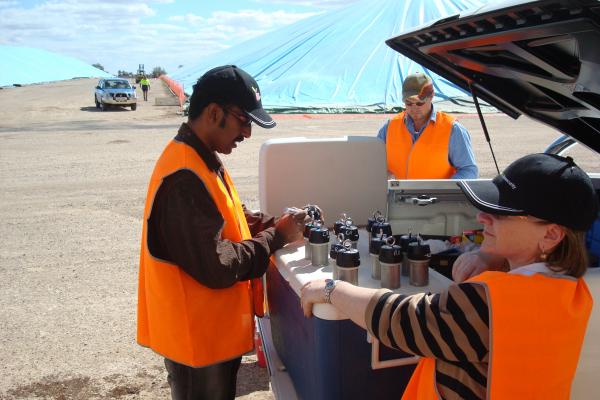phosphine
A range of grain storage pests including beetles, psocids, moths and mites habitually threaten the food safety, market access, trade and the overall profitability and sustainability of the Australian grain industry. Some of these pests have been detected with resistance to phosphine and currently registered contact insecticides (grain protectants) and the spread of resistance is on the rise annually.
Research outcomes:
- Early warning of the emergence of new insect resistances and the spread of known resistance to grain protectants and fumigant phosphine.
- Contribution to the development of strategies to control or limit the spread of resistant insects.
- Maintenance of market access for Australian grain growers.
Research highlights:
The project has been completed with all project milestones achieved on time. During 2007-08, a total of 632 insect samples collected from 115 farms and 150 bulk storages were tested for resistance to phosphine and key grain protectants. The insects comprised of the major pest species: lesser grain borers, flat grain beetles, rice weevils, rust-red flour beetles, saw-toothed grain beetles, psocids and moths. The overall result suggest that the development of resistance to the currently registered grain protectants and fumigant phosphine is a serious issue threatening the profitability and market access of our grain industry.
While the overall frequency of weak resistance to phosphine remained high in lesser grain borers, rust-red flour beetles and rice weevils, the detection of strong resistance in several populations of flat grain beetles has become the emergence resistance issue. This resistance has also been detected by the collaborating researchers in the Southern region (NSWDPI, led by Dr Joanne Holloway). The level of this resistance is high and in response the CRCNPB has initiated a project titled 'Fumigation protocols for the strongly phosphine resistant flat grain beetles' in consultation with end users.
Among the key grain protectants tested, fenitrothion was found to control all strains of rust-red flour beetle, rice weevil and flat grain beetle without any resistance, whereas 60-80% of strains of lesser grain borer were detected with resistance to deltamethrin and s-methoprene. The industry is waiting for the registration of spinosad which will be used particularly to control resistant lesser grain borers.
Research implications:
The evolution of resistance to phosphine and key contact insecticides for the post-harvest protection of grain seriously jeopardises market access for Australian product. There is a need for both strategic and tactical information on the presence/absence and trends in resistance to phosphine and key contact insecticides to underpin resistance management in the grain industry.
Who are the end-users?
Grain growers, bulk handlers, merchants, food processors, flour millers, maltsters, lot feeders and cereal manufacturers.
Acknowledgements
The research team expresses sincere thanks to the managers and field staff of GrainCorp for their support and help for accessing storage sites for collection of insect samples.

PROJECT LEADER

Dr Manoj Nayak
Project Leader CRC30065: Resistance monitoring and management of stored grain insects in the northern region
manoj.nayak@deedi.qld.gov.au
Phone: 07 3896 9431
Fax: 07 3896 9446
Read More
PROJECT DETAILS
Complete
PROGRAM DETAILS
LOCATION
Resistance in grain storage insects to chemical treatments continues to be a problem throughout the southern region. Regional surveys have detected new sites of strong phosphine resistance, with only a few recurrences at previous sites (generally central storages).
Research outcomes
High levels of resistance to phosphine were detected in the flat grain beetle and lesser grain borer in the southern region.
The regional surveys found new sites of strong phosphine resistance which tended to be associated with the storage of grain in unsealed structures.
Levels of resistance to phosphine now being detected in flat grain beetles cannot be controlled with current protocols and threaten management of this insect both on farm and in central storages. This will place increasing pressure on protectant insecticides such as methoprene and deltamethrin and further control failures are predicted throughout NSW, Victoria and South Australia.
Research implications
If resistance to phosphine continues to develop at the rate recently detected in the flat grain beetle, then alternative chemical treatment will be required.
Furthermore, recent changes to the phosphine label state that it is restricted to use in “well-sealed structures” which will further limit accessibility as many farms do not have these structures.
Any new chemical treatments that may be developed will invariably be more expensive than phosphine and are also likely to require added infrastructure costs for application.
However without alternative treatments it is probable that further control failures will occur which will place increasing pressure on the ability of Australia to maintain competitive advantage based on insect-free grain.
To prolong the use of phosphine in the interim period it is recommended that an education and training program be developed for the use and application of phosphine.
This will assist the grain storage industry with an understanding of appropriate and optimal chemical application and fumigation procedures.
Acknowledgements
The NSW Department of Primary Industries would like to acknowledge the following organisations for supporting the project:
- Cooperative Research Centre for National Plant Biosecurity
- Grains Research and Development Corporation
- GrainCorp
- ABB Grain
- NSW Department of Primary Industries
PROJECT LEADER
Dr Joanne Holloway
Project Leader CRC30064: Resistance management of stored grain insects in the southern region
joanne.holloway@industry.nsw.gov.au
Phone: 02 6938 1605
Fax: 02 6938 1625
Read More
PROJECT DETAILS
Complete
PROGRAM DETAILS
Increasing applications of phosphine to stored grain in silos that leak, or grain stored under the wrong conditions, has caused problems with insect pests building up resistance. Proof is needed to show whether phosphine fumigation of cool grain is effective in controlling resistant biotypes of insect pests of stored grain.
Research outcomes:
This project assessed the efficacy of phosphine fumigation against resistant insects in cool grain, i.e. aerated grain or grain that has been harvested and stored in the cooler months of the year, and developed recommendations for Australia’s grain storage industry. Grain temperatures of
20°C or less are considered cool. The project will contribute to keeping Australia’s grain export industry free from insect strains resistant to phosphine. Increasing applications of phosphine to stored grain in silos that leak, or grain stored under the wrong conditions, has caused problems with insect pests building up resistance. Proof is needed to show whether phosphine fumigation of cool grain is effective in controlling resistant biotypes of insect pests of stored grain.
The project has:
- provided reports describing new data on phosphine efficacy at low temperature against resistant grain insects
- provided reports describing new data on phosphine sorption by grain
- provided reports describing new data on phosphine fumigation of cool grain in sealed farm silos, and
- made recommendations to farmers and others within the grain industry.
Recommendations on phosphine fumigation of cool grain have been reported to representatives of the grain industry and national extension network at annual meetings of National Working Party on Grain Protection (NWPGP). Results, recommendations and technology transfer have been provided to the Australian grain industry via the NWPGP and industry forums and publications. CRC partners, bulk grain storage operators and handlers have been informed of the findings.
Research implications
Successful fumigation of resistant insects requires sufficient phosphine concentrations for long enough to control all life stages of the insects. Lower temperatures maintain grain quality and reduce insect population growth, but phosphine is generally less effective at lower temperatures.
The relative importance of phosphine resistant strains of key pests changes with temperature. The most resistant Australian strains of two pests are known to respond similarly to phosphine but the project showed that one species became much harder to control in cool grain.
Sorption will be the major cause of loss of phosphine in a wellsealed silo. Rate of sorption was lower at lower temperature, meaning that higher concentrations will be achieved for longer. Older grain tended to be less sorptive, so delaying fumigation may result in higher concentrations for longer. Sorghum was more sorptive than wheat so the margin for error is smaller for this grain.
In farm silos, phosphine gas was liberated from the aluminium phosphide formulations used despite the low grain and ambient temperatures (e.g. 10°C).
The results for the silo trials varied but three general observations were made. Lower concentrations tended to be measured deeper in grain mass. Lower concentrations tended to be measured on the northern side. Concentrations measured higher in the grain mass tended to peak earlier.
The silo trials showed that control of resistant insect populations is possible subject to good gas-tightness and adequate exposure periods. Exposure to cool temperature alone was not the cause of insect mortality.
Growers and others planning to fumigate cool grain in sealable silos should aim for the current silo pressure test standard of a three minute halving time for a full silo or a five minute halving time for a partially full silo.
The use of forced or passive recirculation methods (e.g. the thermosiphon) should be investigated to promote rapid and even distribution of phosphine from the headspace throughout the grain bulk.
Acknowledgements
The project team is grateful for the cooperation of the following growers and their families: Mr Rodney Petersen (Killarney, Qld) and Mr Raymond Fulwood (Meenaar, WA).
PROJECT LEADER
Dr Greg Daglish
Project Leader CRC50060: Cool Grain Fumigation
greg.daglish@deedi.qld.gov.au
Phone: 07 3896 9415
Fax: 07 3896 9446
Read More
PROJECT DETAILS
Complete
Term
July 2007 – November 2008
Budget
$365,414 (cash and in-kind support)
PROGRAM DETAILS
LOCATION
This project investigated options to overcome the cause of deficient fumigation, sustain the life of phosphine and enable the effective application of new fumigants. It will develop an integrated aeration-fumigation technology for faster, more reliable and sustainable grain disinfestation.
Overall it will develop improvements to the fumigation capability of grain storage facilities, fumigation technologies and practices to better control pest insects and keep Australia's grain export industry free from insect strains resistant to phosphine.
Research outcomes:
- Quantification of each of the phenomena involved in applying fumigants in gas-tight industrial grain stores and demonstrated the significance of each via field trials and mathematical modelling (e.g. sorption, silo breathing, leakage, flow dispersion).
- A data set defining the mortality of representative stored product insects to “interrupted” PH3 doses.
- An extensive data set quantifying phosphine, methyl bromide and ethyl formate sorption by grain.
- A mathematical model defining the kinetics of fumigant sorption by grain.
- A data set defining the intergranular gas flow dispersion coefficients of packed beds of grain.
- A computational fluid dynamics model of fan-forced fumigation based on the significant influences identified with field trials, including industrial scale validation of the fundamental mass transport equation set.
- Simulations of recirculated fumigation in silos.
- Field trial data sets describing phosphine distribution for a recirculated fumigation system in gas-tight silos and losses due to weather influences and grain sorption.
- Evidence based diagnosis of the significant mass transport phenomena that determine the distribution of fumigants in stored grain.
- Performance of a commercial industrial scale fan-forced fumigant dispensing system designed for implementation in large scale grain stores, with a focus on aeration-cooled silos (collaborative effort with manufacturer).
- A commercial prototype system combining fan-forced phosphine fumigation with aeration-cooling in large silos (>1000tonne) addresses the problems identified and is being traded by an industry technology supplier (Kotzur).
Research implications:
- The roles of the factors affecting fumigant doses within fan-forced fumigated grain stores (mortality, distribution, sorption, leakage) were diagnosed with laboratory data and modelling and validated with field trials. These results identified the main causes of fumigation failure and resistance selection with this fumigation system.
- The experimentally determined data sets and mathematical models act as ongoing contributions to the science and technology of grain storage and fumigation which are listed here as follows.
- A data set defining the mortality of representative stored product insects to “interrupted” PH3 doses.
- An extensive data set quantifying phosphine, methyl bromide and ethyl formate sorption by grain.
- A mathematical model defining the kinetics of fumigant sorption by grain.
- A data set defining the intergranular gas flow dispersion coefficients of packed beds of grain.
- A computational fluid dynamics model of fan-forced fumigation based on the significant influences identified with field trials, including industrial scale validation of the fundamental mass transport equation set.
- Field trial data sets describing phosphine distribution for a recirculated fumigation system in gas-tight silos and losses due to weather influences and grain sorption.
- Evidence based diagnosis of the significant mass transport phenomena that determine the distribution of fumigants in stored grain.
- A prototype commercial industrial scale fan-forced fumigant dispensing system designed for implementation in large scale grain stores, with a focus on aeration-cooled silos (collaborative effort with manufacturer) was developed and its performance defined.
- The research results of this project in fan-forced fumigated stores illustrate that selection of PH3 resistant strains of insects is predominantly affected by fumigant distribution versus sorption, and the analysis approach of this work should be continued for non fan-forced grain fumigation systems.
Acknowledgements:
The following collaborators are gratefully acknowledged for the contribution to the success of this project.
- Co-operative Bulk Handling of WA; Ernie Kostas, Graeme George, Alan Bone, Aaron Rhodes, Dean Scott, Phil Taylor.
- CSIRO Ecosystem Sciences; Stephen Beckett, Tracy Willis, Tiffany Cripps, Aaron Barrett, Ben Padovan, Julie Cassells
- GrainCorp Operations Pty Ltd; Matthew Head, Robyn Reid, Warren Bremer, Bruce Cole
- Kotzur Engineering; Andrew Kotzur, Murray Collis, Malcom Bruce, Kevin Hunt, John Bickerton
- University of WA; Professor Liang Cheng, Dr Ming Zhao, Wei He, Dr Pat Morgan
- Viterra SA; Greg Hopkins, Steve Buick, Geoff Masters, Merv Crossman, Grant Haines
PROJECT LEADER
Mr James Darby
Project Leader CRC50059: Fumigation Technology
james.darby@csiro.au
Phone: 02 6246 4197
Fax: 02 6246 4202
Read More
PROJECT DETAILS
Complete
Term
July 2007 – August 2009
Budget
$966,324 (cash and in-kind support)
PROGRAM DETAILS
LOCATION
Boost to fight grain industry biosecurity threat
Media Release: 17 October 2007
A $30 million biosecurity research alliance has been launched to protect Australia's highly valuable grain market.









